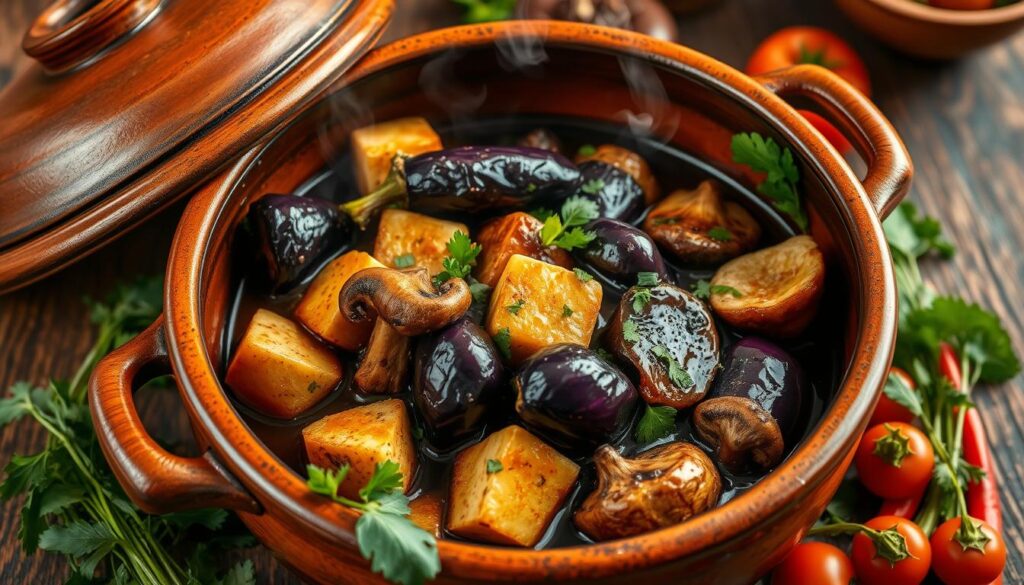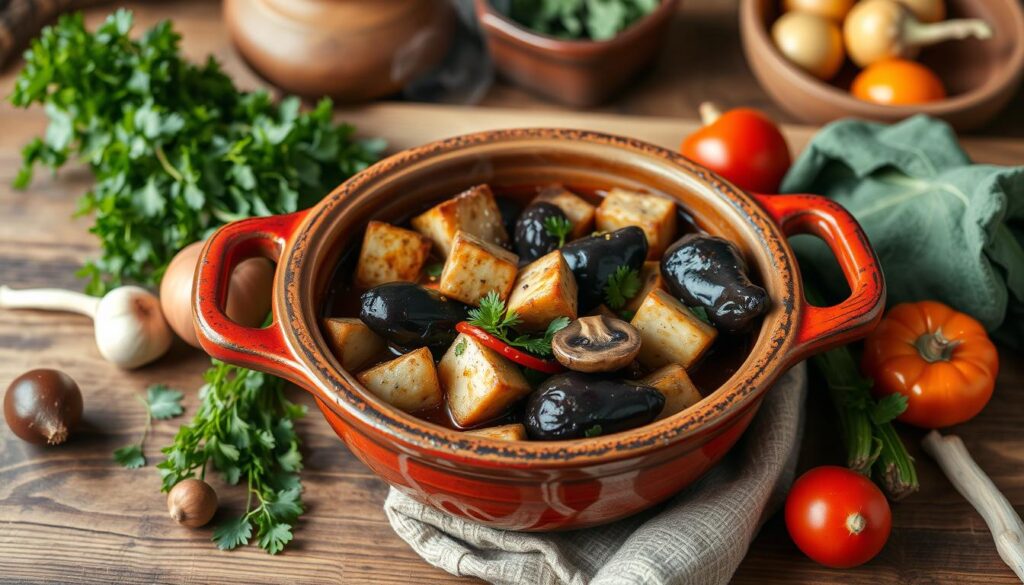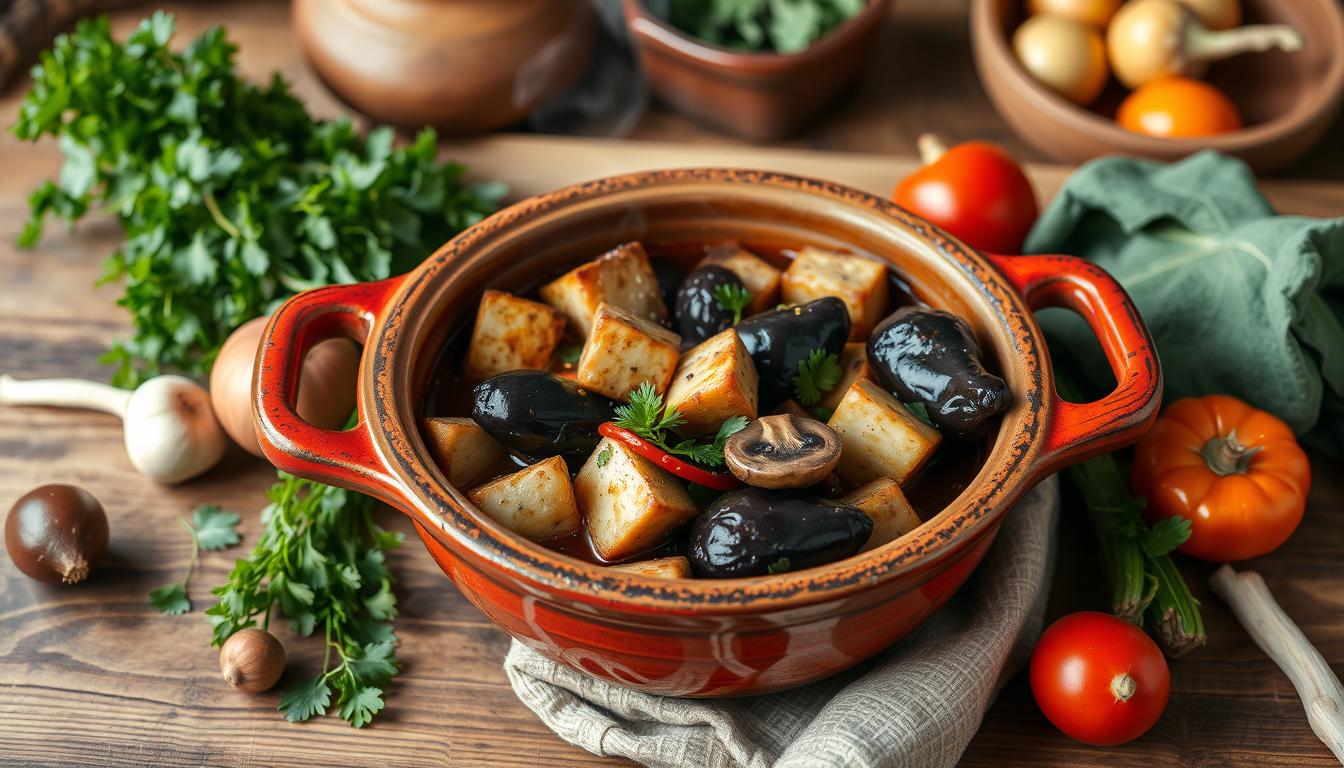
Start your journey into clay pot cooking with this amazing Asian recipe. It turns simple ingredients into a masterpiece. You’ll learn how to make braised eggplant with tofu and shiitake mushrooms. It’s a great way to make your home cooking as good as a restaurant.
Clay pot cooking is a traditional Asian method. It adds depth and complexity to your food. By simmering ingredients slowly, it brings out the best flavors in your dish.
Key Takeaways
- Master the authentic clay pot cooking technique
- Learn how to perfectly braise eggplant and tofu
- Understand the cultural significance of clay pot dishes
- Explore flavor-enhancing slow-cooking methods
- Discover the health benefits of clay pot cuisine
The Art of Clay Pot Cooking in Asian Cuisine
Clay pot cooking is a deep tradition that turns simple ingredients into amazing meals. These special pots have been key in Asian cooking for ages. They do more than cook food; they connect us to our culinary past.
Explore the world of traditional cookware that has shaped Asian cuisine. Clay pots add something special to your kitchen. They make cooking an experience unlike any other.
Traditional Clay Pot Construction and Properties
Clay pots are made with great care. They are made of materials that let in air and water. This makes them special for cooking.
- Natural heat retention
- Gradual moisture circulation
- Enhanced flavor development
- Even temperature distribution
Heat Distribution Benefits in Clay Pot Cooking
The way clay pots distribute heat changes cooking. Unlike metal cookware, they cook gently. This keeps food tender and brings out flavors.
| Cooking Characteristic | Clay Pot Advantage |
|---|---|
| Heat Retention | Superior compared to metal cookware |
| Moisture Preservation | Keeps ingredients tender and juicy |
| Flavor Concentration | Enhances natural ingredient tastes |
Cultural Significance of Clay Pot Dishes
“In every clay pot, there’s a story of tradition, family, and culinary heritage.”
Clay pot cooking is more than cooking. It’s a way to connect families and keep traditions alive. It celebrates the spirit of Asian dining.
From the Hakka suburbs of Chengdu to kitchens around the world, clay pot cooking is loved. It brings together home cooks and chefs, linking past and present through amazing cooking.
Essential Ingredients for Perfect Clay Pot Braising
To make a great braised eggplant dish, you need the right ingredients. Knowing about eggplant types, tofu, and shiitake mushrooms will make your clay pot cooking better.
For braising, choose Chinese or Japanese eggplants. They are tender and have mild flavors. Their thin skin and soft flesh are great for clay pot cooking.
Key Ingredient Breakdown
- Eggplant Varieties:
- Chinese eggplant: Slender, mild flavor
- Japanese eggplant: Tender, smooth texture
- Tofu Types:
- Silken tofu: Soft, delicate consistency
- Firm tofu: Ideal for braising, holds shape well
- Shiitake Mushrooms:
- Fresh shiitake: Intense umami flavor
- Dried shiitake: Concentrated earthy notes
“The secret to exceptional clay pot dishes lies in ingredient selection and understanding their unique characteristics.”
Shiitake mushrooms add a deep flavor to your braising liquid. Whether fresh or dried, they bring a rich umami taste that makes your dish special.
| Ingredient | Recommended Quantity | Cooking Tip |
|---|---|---|
| Eggplant | 2-3 medium pieces | Slice diagonally for even cooking |
| Tofu | 8-10 puffs | Pat dry before adding to clay pot |
| Shiitake Mushrooms | 8 whole mushrooms | Soak dried mushrooms for 30 minutes |
Your success in clay pot braising depends on the quality and preparation of your ingredients. Choose fresh, high-quality items to make your dish shine.
Preparing Eggplant with Tofu and Shiitake Mushrooms
Making a great clay pot dish starts with picking the right ingredients. You need to choose top-quality items and learn how to prepare them well. This will make your dish taste amazing.
Selecting the Freshest Ingredients
Quality is key when picking ingredients for your clay pot dish. Here are some tips for eggplant:
- Choose Chinese eggplants with firm, glossy skin
- Avoid eggplants with blemishes or soft spots
- Look for vibrant purple coloration
- Choose eggplants weighing between 14-16 ounces
Proper Mushroom Soaking Techniques
Soaking mushrooms is important to get the most flavor. Here’s how to soak dried shiitake mushrooms:
- Rinse dried mushrooms under cold water
- Soak in warm water for 15-20 minutes
- Squeeze out excess moisture
- Slice thinly for optimal texture
Tofu Preparation Methods
Getting tofu right is all about the texture. Here’s how to prepare it:
- Press tofu for 15-20 minutes to remove excess moisture
- Cut into two-inch cubes for consistent cooking
- Pat dry with paper towels before cooking
- Optional: Lightly pan-fry for a firmer exterior
Pro tip: The key to a successful clay pot dish lies in precise ingredient preparation and attention to detail.
By using these preparation tips, you’ll make a tasty clay pot dish. It will have the best flavors from eggplant, tofu, and shiitake mushrooms.
Clay Pot Seasoning and Maintenance Tips
Learning how to care for your clay pot is key for any home cook. Knowing how to season and maintain your cookware can make it last longer. It also improves how well it cooks.
- Soak the clay pot in water for 24 hours before first use
- Gradually heat the pot to prevent thermal shock
- Start with low to medium heat settings
- Fill the pot only three-quarters full during initial seasoning
Proper cleaning and maintenance are crucial to keep your clay pot in good shape:
- Always clean with soft sponges
- Avoid harsh detergents
- Dry thoroughly after each use
- Store in a cool, dry place
“A well-maintained clay pot can last generations when treated with proper care and respect.”
Understanding your clay pot’s unique needs is part of its maintenance. Its porous surface needs gentle care to avoid damage. This ensures it cooks well for a long time.
| Maintenance Step | Recommended Action |
|---|---|
| Soaking | 24 hours before first use |
| Heating | Gradual, low to medium heat |
| Cooling | Room temperature |
| Cleaning | Soft sponge, no harsh chemicals |
By following these tips, your clay pot will stay in great shape. It will be ready to help you cook delicious meals for many years.
Mastering the Braising Technique
Braising techniques need precision and knowledge to turn simple ingredients into amazing dishes. The art of clay pot cooking requires careful attention to temperature and cooking methods. These steps bring out the best flavors in your ingredients.
Perfecting braising techniques involves several key steps. These steps take your cooking from ordinary to exceptional. Understanding how to control clay pot temperature is crucial for great results.
Temperature Control Guidelines
- Start with medium-low heat to begin the braising process
- Keep the temperature steady between 180-200°F
- Use a kitchen thermometer for accurate monitoring
- Adjust the heat to avoid rapid boiling or excessive simmering
Timing and Texture Management
Managing texture is key in braising. The cooking time affects the tenderness of ingredients like eggplant, tofu, and shiitake mushrooms.
| Ingredient | Ideal Braising Time | Texture Goal |
|---|---|---|
| Eggplant | 15-20 minutes | Soft but not mushy |
| Tofu | 10-15 minutes | Firm and absorbent |
| Shiitake Mushrooms | 12-18 minutes | Tender with concentrated flavor |
Sauce Reduction Methods
Sauce reduction is an art that enhances flavors and creates a rich, velvety sauce. By managing heat and cooking time carefully, you can turn your braising liquid into a flavorful sauce.
“The secret to an exceptional sauce is patience and controlled heat.” – Master Chef Liu
- Remove ingredients when nearly done
- Increase heat slightly to reduce sauce
- Stir frequently to prevent burning
- Aim for a glossy, coat-the-spoon consistency
Mastering these braising techniques ensures your clay pot dishes are consistently delicious. They will have perfectly cooked ingredients and intensely flavored sauces.
Regional Variations of Clay Pot Dishes

Clay pot cooking is a rich tapestry of Asian culinary traditions. Each region adds its own flavor and cooking technique. This makes Asian clay pot recipes incredibly diverse.
China’s culinary landscape is full of regional variations in clay pot cooking. The country has eight distinct regional cuisines. Each one has its own way of preparing clay pot dishes.
- Cantonese cuisine focuses on subtle flavors and preserving ingredient authenticity
- Sichuan clay pots feature bold, spicy preparations
- Hunan region emphasizes complex, fiery flavor combinations
- Jiangsu cuisine highlights delicate, elegant clay pot techniques
Some popular clay pot dishes from around the world include:
- Szechuan Spicy Pot – A mouth-numbing delicacy packed with chili and peppercorns
- Chicken Mushroom Claypot Rice from Guangdong Province
- Spicy Beef Claypot Rice featuring intricate spice blends
“Each clay pot dish tells a story of its regional heritage, transforming simple ingredients into culinary masterpieces.” – Traditional Asian Cooking Wisdom
Knowing about these regional cuisine nuances lets home cooks explore authentic flavors. They can also try traditional cooking methods. This brings a world of taste into their kitchen.
Pairing Suggestions and Serving Recommendations
Make your clay pot eggplant dish even better with Asian food pairings. These pairings turn your meal into a special experience. The right serving suggestions can make your dish taste and look amazing.
Choose side dishes that go well with your braised eggplant. Add tofu and shiitake mushrooms for extra flavor. Your meal will be unforgettable with the right sides.
Complementary Side Dishes
- Steamed bok choy with light sesame oil
- Pickled vegetable medley
- Jasmine rice with fresh herbs
- Crisp cucumber salad
Beverage Pairings
Choosing the right drink can make your clay pot dish even better. Here are some great options:
- Green tea: Cleanses the palate
- Sake: Traditional Japanese pairing
- Light Riesling: Complements umami flavors
- Sapporo beer: Refreshing alternative
Presentation Tips
Make your meal look like a true Asian feast with these tips:
- Serve directly in the clay pot for traditional presentation
- Garnish with fresh cilantro or green onions
- Use white ceramic plates to highlight dish colors
- Arrange side dishes symmetrically around the main course
“The art of serving is as important as the cooking itself.” – Chef Ming Tsai
Health Benefits of Clay Pot Cooking

Clay pot cooking is a game-changer for healthy cooking. It offers nutritional benefits that traditional methods can’t match. This method changes how we cook and eat.
Choosing clay pot cooking means you’re cooking with less fat. The clay’s pores help distribute heat well. This way, you can cook with little oil but still get deep flavors.
- Retains up to 90% of nutrients during cooking
- Reduces need for added fats by approximately 30%
- Enhances antioxidant content by up to 40%
- Improves overall digestive comfort
“Clay pot cooking is not just a method, it’s a holistic approach to nutritious meal preparation.” – Culinary Nutrition Expert
Clay pots can make acidic foods easier to digest. They help balance the body’s pH levels. This method is good for your health because it keeps more nutrients in your food.
Studies show clay pot cooking is getting more popular. It’s a favorite among those who care about their health. By using this method, you’re not just cooking a meal. You’re taking care of your body with a cooking tradition that preserves nutrients.
Troubleshooting Common Clay Pot Cooking Issues
Clay pot cooking can be tricky for home chefs. Knowing how to fix common problems helps you get perfect food texture every time.
When using clay pots, you might face a few issues. Here are some tips to make sure your dishes are amazing.
- Prevent clay pot cracking by gradually heating your pot
- Use proper seasoning techniques to reduce sticking
- Manage heat distribution carefully
Common Clay Pot Cooking Challenges
| Problem | Solution |
|---|---|
| Uneven Heating | Use low to medium heat, rotate pot periodically |
| Ingredient Sticking | Pre-season pot, use light oil coating |
| Texture Inconsistencies | Monitor cooking times, adjust heat levels |
For texture problems, focus on how you prepare your ingredients. Pre-soaking eggplants in a vinegar water solution helps keep color and reduces oil. Use 3.5 cups water to 3.5 tbsp distilled vinegar.
“Mastering clay pot cooking requires patience and practice” – Traditional Asian Culinary Wisdom
By learning these tips, you can turn clay pot challenges into successes. Remember, every problem is a chance to get better.
Conclusion
Your journey through Asian cooking techniques has shown the power of clay pot cooking. It lets you make gourmet meals at home that feel like a trip around the world. Clay pot cooking is more than just cooking; it connects you to ancient traditions.
Tofu, a key ingredient in Asian cooking for over 2,000 years, is very versatile. It’s misunderstood in North America but is a game-changer in the kitchen. Paired with ingredients like shiitake mushrooms and eggplant, tofu brings amazing flavors and textures.
Keep practicing clay pot cooking. Each try gets you better at it, helping you understand how ingredients work together. Your kitchen becomes a place where old traditions meet new ideas, turning simple ingredients into amazing dishes.
Start your clay pot cooking adventure, try new flavors, and enjoy the tasty results. Cooking is more than just making food; it’s about creating moments that feed both your body and soul.
FAQ
What makes clay pot cooking different from other cooking methods?
Clay pot cooking is special because of its porous nature. It distributes heat evenly. This method cooks food slowly, keeping nutrients and flavors intact. It also uses less oil than traditional methods.
Which type of eggplant is best for braising in a clay pot?
Chinese or Japanese eggplants work best for braising. They have a tender texture and mild taste. Choose eggplants with firm, glossy skin for the best results.
How do I properly prepare tofu for a clay pot recipe?
First, press the tofu to remove excess moisture. You can also pre-fry it for a firmer texture. Use silken or extra-firm tofu based on your dish’s consistency needs.
How do I season and maintain my clay pot?
Seasoning a new clay pot is a step-by-step process. It prevents cracking and improves non-stick properties. Clean it carefully and store it to avoid moisture buildup and mold.
What are some tips for braising in a clay pot?
Master braising by controlling the temperature. Aim for a simmering to gentle boiling range. Manage cooking times to get the right texture for ingredients. Reduce the sauce to concentrate flavors.
Are there health benefits to clay pot cooking?
Yes, clay pot cooking has health benefits. It uses less oil, making dishes lower in fat. The even heat retention keeps more nutrients in food. Clay’s alkaline properties can also balance food pH levels.
What are some common challenges when cooking with a clay pot?
Challenges include preventing cracks, avoiding sticking, and managing cooking times and temperatures. With proper technique and attention, you can overcome these and make perfect dishes.
Can I use a clay pot for different types of cuisine?
Clay pot cooking is popular in many Asian cuisines. You can try Chinese claypot rice, Korean dolsot bibimbap, and Szechuan Spicy Pot. Experiment with ingredients and techniques to create fusion dishes.

